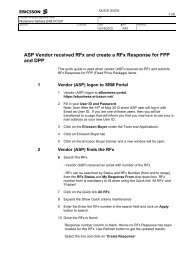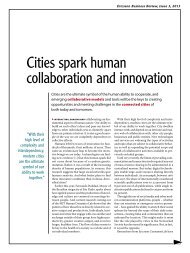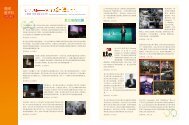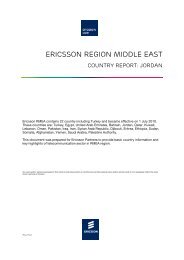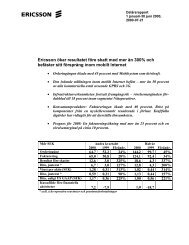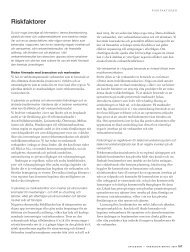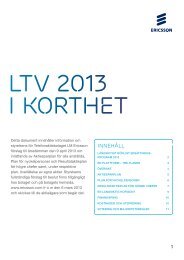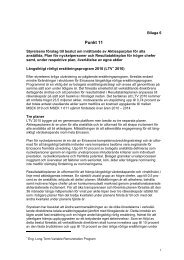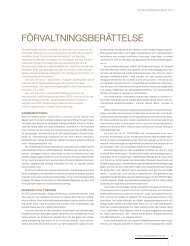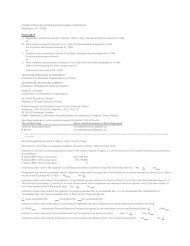Telenor's - Ericsson
Telenor's - Ericsson
Telenor's - Ericsson
- TAGS
- ericsson
- www.ericsson.com
You also want an ePaper? Increase the reach of your titles
YUMPU automatically turns print PDFs into web optimized ePapers that Google loves.
the future of devices strategy<br />
Birth of the “connect-me” era<br />
▶ In the summer of 2007, the longrumored<br />
iPhone was launched. Market<br />
expectations were high; Apple<br />
had previously had tremendous success<br />
with the iPod and its related service,<br />
the iTunes music store. When<br />
the first iPhone was unveiled, the<br />
telecom industry was astonished that<br />
Apple had introduced a product that<br />
not only lacked all the latest technological<br />
features, but was not even<br />
compliant with major operators’<br />
requirements – it didn’t even have 3G<br />
or MMS.<br />
However, instead of getting into<br />
the same phone hardware battle as<br />
the rest of the industry, Apple prioritized<br />
superior user experience combined<br />
with the ability to download<br />
content and applications; to manage<br />
the device via iTunes; and to connect<br />
to Apple’s already established<br />
ecosystem.<br />
The iPhone was a classic case of<br />
market disruption, and completely<br />
shifted the industry focus; suddenly<br />
everyone was occupied with creating<br />
smartphones with touch screens and<br />
application stores. Google entered<br />
the wireless-device industry shortly<br />
after Apple. But it did so from a different<br />
angle, by offering the Android<br />
open-source operating system with<br />
its ecosystem of third-party developers<br />
attached for free to the device<br />
manufacturers, and thereby further<br />
stimulating the ongoing transition.<br />
56 EBR #3 2010<br />
Looking ahead, we are now entering<br />
a new phase, where services will be available<br />
anywhere, and where everything and<br />
anything will be connected. The key trends<br />
described below point to a time when anywhere<br />
is the common denominator, and this<br />
will have implications for the future of<br />
wireless applications.<br />
KEY TRENDS<br />
Everything and anything gets connected:<br />
Modems and connectivity enable new types<br />
of devices and services driven by increasing<br />
consumer demand for mobility. We have<br />
already witnessed the take-up of mobile<br />
broadband in the pc industry. The next<br />
growth areas will be m2m and consumer<br />
electronics, with cars, homes, cameras,<br />
vending machines, refrigerators and tvs<br />
among the items getting connected.<br />
New business models with alternative billing<br />
structures such as one-stop shops, and<br />
the ad-funded model, along with more<br />
simplified modularized plug-and-play solutions,<br />
will make it easier for newcomers to<br />
focus on the value-added service instead of<br />
the enabling technologies. The biggest<br />
hurdle today to scaling a business for mobile<br />
devices is managing the complexity of all<br />
unique network characteristics, which<br />
requires costly hands-on interoperability<br />
testing, certification and type approval for<br />
each individual market.<br />
Ecosystems – the new world order: The<br />
increasing interdependency between the key<br />
stakeholders on the market (already important<br />
during the previous era) changes the<br />
boundaries of how we define a company and<br />
a product proposition. Today a company<br />
must manage and balance the interests of<br />
standardization bodies, partners and opensource<br />
communities as well as third-party<br />
developers, which all contribute to creating<br />
value for its products. Devices and services<br />
go together, and their actual value is in the<br />
joint offering, not the components. It is clear<br />
that mobile devices are going the way of pcs,<br />
with their value vanishing unless services<br />
are attached.<br />
Also evident from today’s market is the<br />
growing importance of managing ecosystems<br />
across verticals. Here, the user experience<br />
is the focal point, meaning access to<br />
services as well as remote access to content<br />
on any device with a unified user experience.<br />
Apple has established a strong position with<br />
the iTunes Store, addressing multiple vertical<br />
applications and continuously broadening<br />
the scope with iTunes as the horizontal<br />
glue layer between the various vertical<br />
applications. The iTunes application is available<br />
for both the pc and the Mac environment,<br />
and works as the tool for managing<br />
devices, content and services. New categories,<br />
technologies and quality levels of<br />
content and services have been added<br />
continuously: for example, downloadable<br />
music, audio books, movies, tv-series, podcasts<br />
(both audio and video), applications<br />
(programs and games), and eBooks for<br />
iPhone, iPad, Apple tv and iPod. And on the<br />
horizon are streaming services and a more<br />
accessible cloud-based service offering.<br />
The cloud is taking over: As data moves<br />
to the cloud, so does computing. Services<br />
are now available on the web, and the browser<br />
is becoming an ever-richer application<br />
environment. The shift towards mobile<br />
cloud computing means that we are moving<br />
towards an infrastructure where both storing<br />
and processing of data takes place outside<br />
the mobile device.<br />
We already have access to numerous<br />
mobile cloud computing applications,<br />
including Spotify, Google Maps, Gmail, and<br />
Facebook. Social networks play an increasing<br />
role in our lives; and, after developing<br />
them on the desktop, we are now seeing<br />
them evolve in the mobile environment. In<br />
February 2010 Facebook announced that the<br />
number of mobile users had passed 100 million,<br />
with a higher growth rate for mobile<br />
than desktop. In May 2010 it was announced<br />
that Facebook was the most visited site in<br />
the world. However, data storage and<br />
processing for the majority of applications<br />
still takes place on the mobile devices themselves<br />
and not in the cloud.<br />
Same service – any screen: Content and<br />
service convergence across multiple screens<br />
is the next opportunity to create value. Some<br />
view this as a key development and an alternative<br />
to diversification into services. A user<br />
can, for example, start watching a high-definition<br />
video stream at home on the tv, then<br />
leave the house and continue to watch via<br />
a mobile device. A typical data stream for<br />
high definition would consume 6–8Mbps –<br />
not much for an lte network that will have<br />
typical user rates of 10-100Mbps.<br />
As cloud-based content and services grow,<br />
it is increasingly important that everything<br />
works the same way across all devices. The<br />
key to success is a framework for unifying<br />
devices across all screens and integrating<br />
services across device types. New devices<br />
will facilitate service partnerships, with<br />
seamless transitions between different entry<br />
points enabling access to the same services.<br />
Finally it and telecoms will converge.<br />
Continued value shift from hard to soft:<br />
The wireless device industry is coming<br />
closer to the pc value-chain paradigm with<br />
modularized hardware, software and services.<br />
For device manufacturers, differentiation<br />
and value addition are increasingly coming



